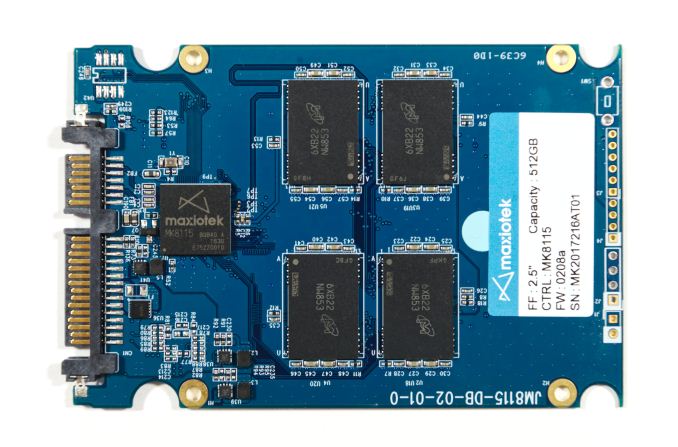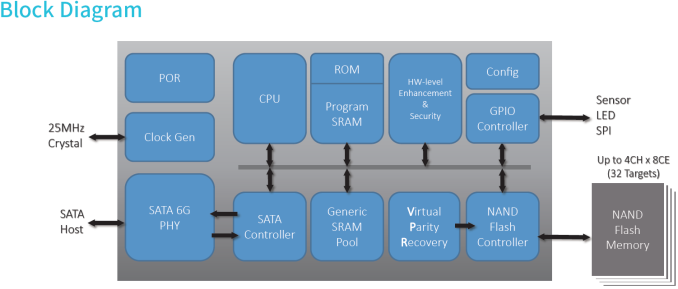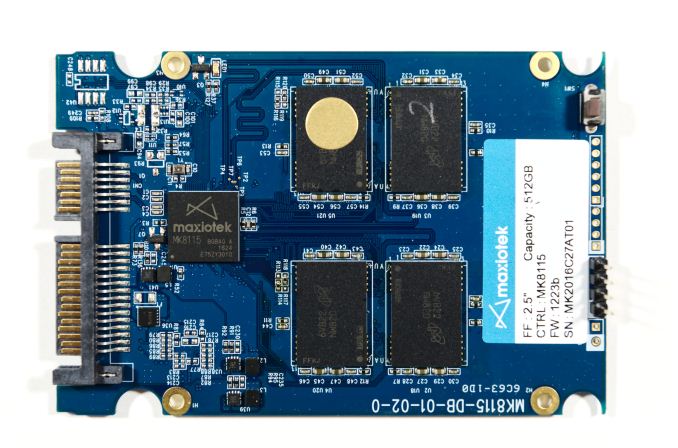
Original Link: https://www.anandtech.com/show/11339/previewing-maxiotek-mk8115-dramless-ssd-controller
Previewing Maxiotek's MK8115 SSD Controller: Can DRAM-less Drives Make The Cut?
by Billy Tallis on May 9, 2017 8:00 AM EST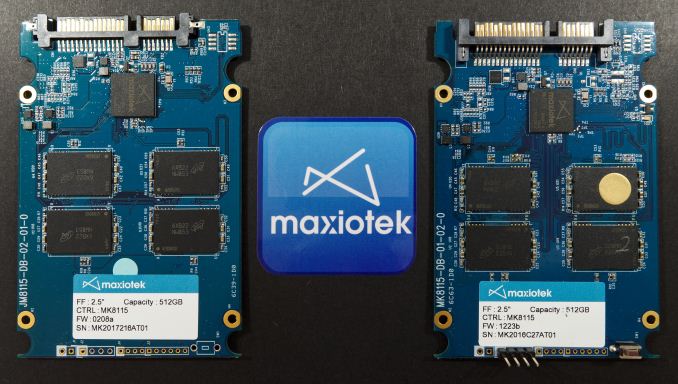
Maxiotek is a very new name in the SSD market, but there's a long history behind the company. Last year, JMicron spun off their SSD controller business into Maxiotek, and the new company has retained the same engineering team and roadmap. Their first new SSD controller since being spun off is the Maxiotek MK8115, and recently we've finished testing on 512GB engineering samples that use it with both Micron 3D MLC and TLC.
JMicron was one of the oldest players in the SSD market. When MLC SSDs first started to become affordable enough for some consumers, the JMicron JMF602 controller dominated the market, usually paired with Samsung MLC NAND flash. JMicron's turnkey solution was the starting point for many memory companies' entry into the SSD market. However, JMicron's fortunes changed when Intel got into the game with the X25-M and set a new standard for SSD performance. The X25-M put the JMF602 to shame and JMicron's reputation and market share have never fully recovered. JMicron's controllers matured along with the rest of the SSD market, but they've never been ahead of the curve and have largely been relegated to competing at the low end of the market.
The JMicron SSD controller roadmap largely survived the transition to Maxiotek's independence, but everything got renamed and a few plans were changed. A few existing JMicron controllers are still for sale under their existing names, but even the flagship JMF670H is quite outdated, with a limit of 512GB capacity and no support for TLC NAND.
The first of the new Maxiotek-branded controllers is the MK8115 SATA SSD controller. The MK8115 was originally planned to be an entry level solution, but for now it serves as the replacement for all the remaining JMicron SSD controllers. MK8115 is a big step forward: it increases the maximum drive capacity to 1TB, it adds support for 3D MLC and TLC, SLC caching, TCG OPAL encryption, and more robust error correction.
The MK8115 controller does not use an external DRAM cache. DRAM-less controllers allow for a lower total bill of materials and a simpler and more compact PCB layout, but at the cost of lower performance. Mainstream SSD controllers typically use 1GB of DRAM for every 1TB of flash; this DRAM is not used to store user data that is in flight but to cache the metadata about where each logical block address is physically stored on the flash memory. Due to the wear leveling flash SSDs require, this information is constantly shifting with every write and it must be consulted for every read operation.
Meanwhile also on Maxiotek's roadmap and due to hit the market this year is the MK8113 controller. Based on the same die as the MK8115, MK8113 will use a larger BGA package to enable an external DRAM interface with support for up to 2GB of DRAM and thus 2TB of flash. A successor generation consisting of MK8213 and MK8215 will further improve the error correction capabilities with codes comparable to LDPC, allowing cheap planar TLC to be supported with acceptable write endurance. The MK821x controllers are expected to be used mainly in ultra low-cost SSDs that are unlikely to be sold in the North American market, which is increasingly using 3D NAND that Maxiotek feels does not require the higher-overhead error correction.
Maxiotex also has PCIe SSD controllers in the works, again in pairs with and without external DRAM support. MK8112 (DRAM-less) and MK8111 will use PCIe 3 x2 and AHCI instead of NVMe, so they will have a tough time catching on unless they are no more expensive than SATA. A later MK83xx generation will switch to NVMe and add support for the Host Memory Buffer feature that alleviates the worst limitations of DRAM-less SSD controllers. However Maxiotek hasn't given any target dates for controllers other than the current MK8115 and MK8113.
Testing Maxiotek's MK8115 512GB Engineering Samples
The two MK8115 engineering samples we tested used different revisions of the PCB layout and different firmware versions, but the general design is similar. The controller and four NAND packages are the only large components on the top side, and there's plenty of empty space. The back side has a handful of smaller components and empty pads for four more NAND packages as well as for the power loss protection capacitors enterprise and industrial models would require. The 512GB drive with 3D MLC is using four 32GB dies per package while the TLC drive is using three 48GB dies per package for a much larger overprovisioning ratio.
Maxiotek's first design win for the MK8115 was recently released: the ADATA Ultimate SU700. The SU700 pairs the MK8115 controller with Micron 3D TLC NAND, and is positioned just below the SU800 (Micron 3D TLC with Silicon Motion SM2258 controller) as ADATA's new entry-level 3D NAND SSD. The SU700 is also using higher levels of overprovisioning than our engineering samples of MK8115; whereas our samples are 512GB, ADATA ships its equivalent SU700 with an end-user capacity of 480GB, while the other SU700 capacities are 120, 240, and 960GB.
The MK8115 is the first SSD controller from Maxiotek to ship, but the last generation of JMicron SSDs are an interesting point of comparison as they are effectively the ancestors of this new controller. We have results for both the ADATA XPG SX930 and an earlier engineering sample of the same JMF670H controller. Both of those drives used planar MLC NAND.
We have not yet tested any other SATA SSDs using Micron's 3D MLC NAND (only ADATA has started shipping such a drive), so we're including the results for a PCIe SSD that uses Micron 3D MLC. That drive was an engineering sample of the Silicon Motion SM2260 platform, which is now retailing as the ADATA XPG SX8000.
Micron's 3D TLC has seen wider adoption and is used in the Crucial MX300 and ADATA Ultimate SU800. Intel's version of the same 3D TLC design is used in the Intel SSD 600p, one of the cheapest PCIe SSDs on the market. These drives offer the best comparisons of how the MK8115 stacks up against other controller designs from Marvell and Silicon Motion.
We have not tested many DRAM-less SSDs in recent years. The Phison S11, Marvell 88NV1120 and Silicon Motion SM2258XT are the primary competitors at the moment, but we have not yet tested drives using any of those controllers. The OCZ VX500 used Toshiba 15nm MLC with a controller that supports external DRAM, but only the 1TB model was populated with extra DRAM, and only 256MB. It's possible that the 512GB VX500 has some DRAM built-in to the controller package.
| AnandTech 2015 SSD Test System | |
| CPU | Intel Core i7-4770K running at 3.5GHz (Turbo & EIST enabled, C-states disabled) |
| Motherboard | ASUS Z97 Pro (BIOS 2702) |
| Chipset | Intel Z97 |
| Memory | Corsair Vengeance DDR3-1866 2x8GB (9-10-9-27 2T) |
| Graphics | Intel HD Graphics 4600 |
| Desktop Resolution | 1920 x 1200 |
| OS | Windows 8.1 x64 |
- Thanks to Intel for the Core i7-4770K CPU
- Thanks to ASUS for the Z97 Deluxe motherboard
- Thanks to Corsair for the Vengeance 16GB DDR3-1866 DRAM kit, RM750 power supply, Carbide 200R case, and Hydro H60 CPU cooler
Performance Consistency
Our performance consistency test explores the extent to which a drive can reliably sustain performance during a long-duration random write test. Specifications for consumer drives typically list peak performance numbers only attainable in ideal conditions. The performance in a worst-case scenario can be drastically different as over the course of a long test drives can run out of spare area, have to start performing garbage collection, and sometimes even reach power or thermal limits.
In addition to an overall decline in performance, a long test can show patterns in how performance varies on shorter timescales. Some drives will exhibit very little variance in performance from second to second, while others will show massive drops in performance during each garbage collection cycle but otherwise maintain good performance, and others show constantly wide variance. If a drive periodically slows to hard drive levels of performance, it may feel slow to use even if its overall average performance is very high.
To maximally stress the drive's controller and force it to perform garbage collection and wear leveling, this test conducts 4kB random writes with a queue depth of 32. The drive is filled before the start of the test, and the test duration is one hour. Any spare area will be exhausted early in the test and by the end of the hour even the largest drives with the most overprovisioning will have reached a steady state. We use the last 400 seconds of the test to score the drive both on steady-state average writes per second and on its performance divided by the standard deviation.
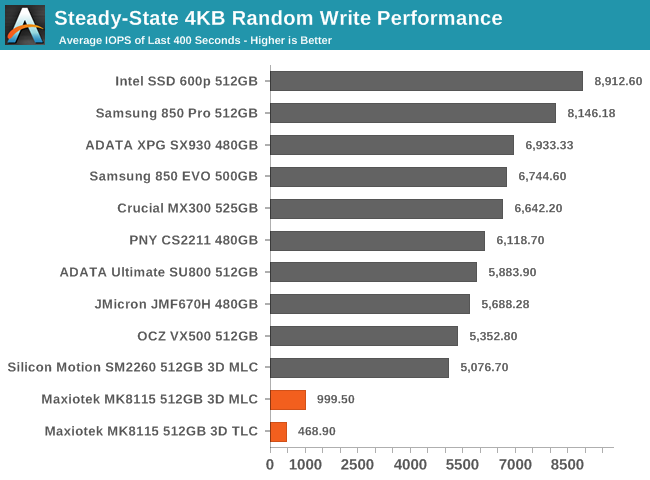
No, that's not a mistake. The abysmal steady-state performance of both MK8115 prototypes is a consequence of not having a cache for the logical to physical address mapping. Each write in this test is overwriting an in-use logical block address. While the controller's wear leveling ensures that the new data will go to a new location (the physical address of which is probably kept in a register on the controller), the controller has to read from the flash to figure out which physical page just got invalidated and became a candidate for garbage collection. Meanwhile, the garbage collection process has to scan the flash instead of a DRAM cache in order to determine if all the pages in an erase block contain stale data or if there's some live data that needs to be moved before the controller can erase that block.
This test isn't easy for any consumer SSD, but a DRAM-less SSD suffers acutely. Still, in spite of all the barriers to efficient flash management, the MK8115 drives are faster than a hard drive.

The MK8115 samples have poor steady-state throughput, but their consistency is pretty good. Maxiotek has ensured that the garbage collection never completely stalls the drive's progress on completing host write operations.
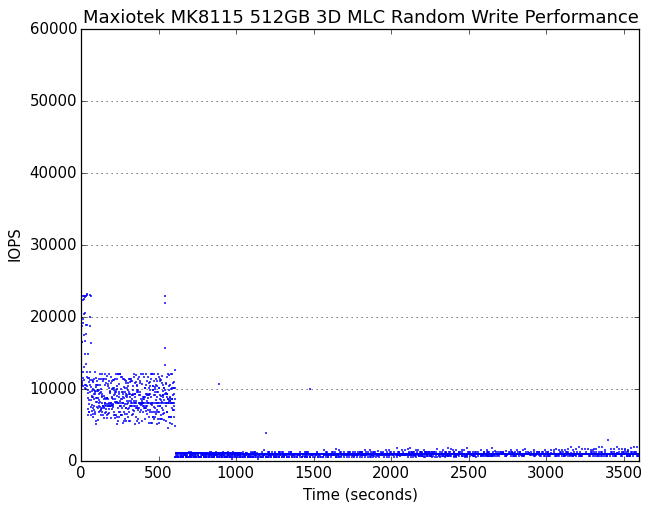 |
|||||||||
| Default | |||||||||
| 25% Over-Provisioning | |||||||||
Before the MK8115 SSDs run out of spare area, their random write speeds aren't horrific, and are better than what most SSDs manage in steady state. It's only when the spare area runs out that the MK8115 gets into serious trouble. The TLC drive takes longer to reach this point, because the odd 48GB capacity of Micron's 3D TLC forced Maxiotek to give the drive much more overprovisioning than a typical 512GB SSD.
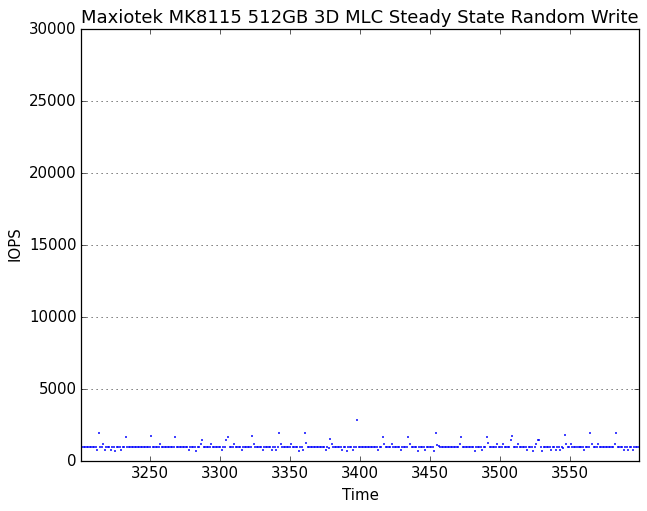 |
|||||||||
| Default | |||||||||
| 25% Over-Provisioning | |||||||||
There is some cyclical behavior in the steady state of the MK8115 drives, but less than for most SSDs. The MLC drive in particular is extremely consistent save for periodic but very short bursts of higher performance.
AnandTech Storage Bench - The Destroyer
The Destroyer is an extremely long test replicating the access patterns of very IO-intensive desktop usage. A detailed breakdown can be found in this article. Like real-world usage and unlike our Iometer tests, the drives do get the occasional break that allows for some background garbage collection and flushing caches, but those idle times are limited to 25ms so that it doesn't take all week to run the test.
We quantify performance on this test by reporting the drive's average data throughput, a few data points about its latency, and the total energy used by the drive over the course of the test.
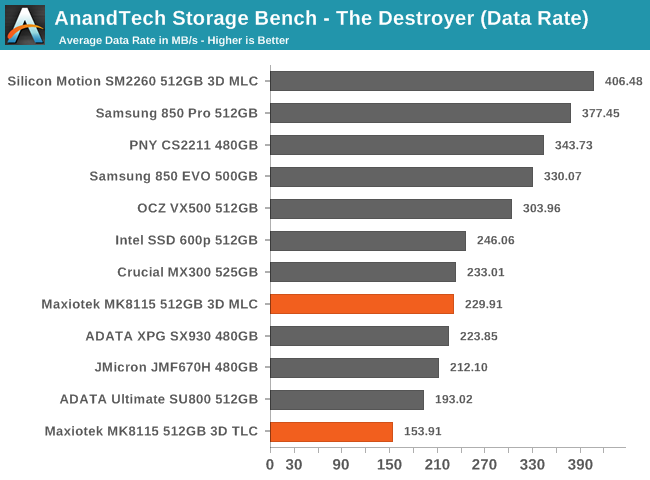
As expected, the MK8115 drives perform relatively poorly overall on The Destroyer. The TLC drive's average data rate is about 20% slower than the next slowest drive in this comparison. The MLC sample actually manages to slightly outperform the earlier JMicron drives, which weren't even handicapped by a lack of external DRAM. However, relative to current MLC drives, the MK8115 MLC drive is about 25% slower overall on this test.
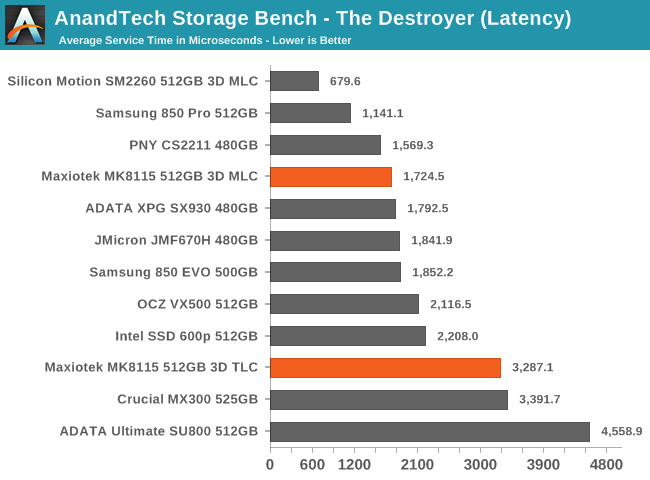
The average service times of the MK8115 drives aren't particularly bad. The TLC drive's average service time is lower than either of the other two SATA drives using the same Micron 3D TLC. The MK8115 sample with MLC is slower than the Samsung 850 PRO and PNY CS2211, but slightly faster than the JMicron drives and the OCZ VX500.
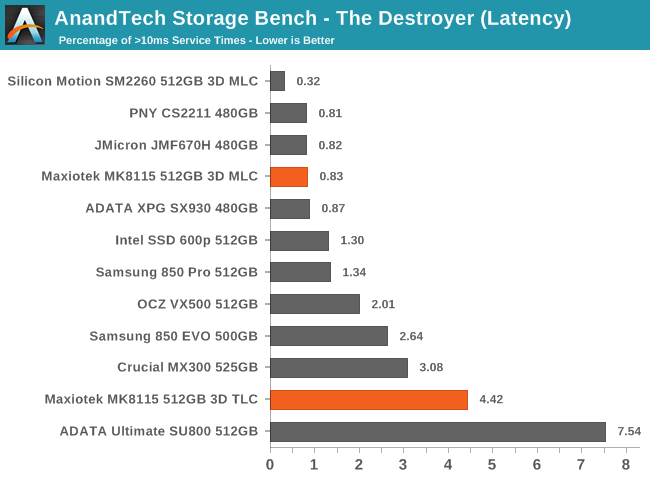
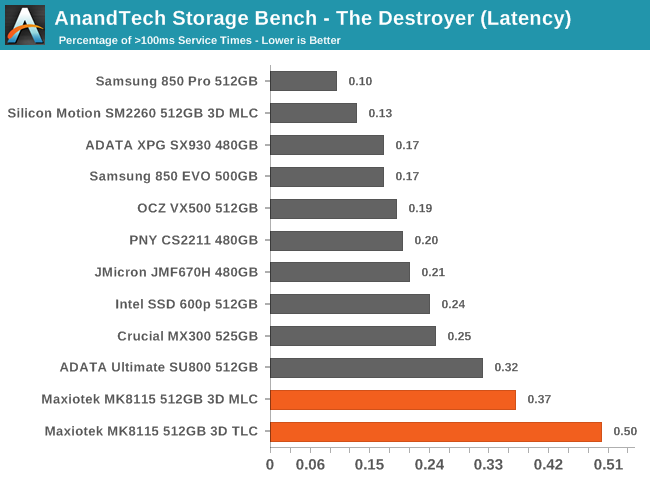
The MK8115 drives do a decent job of keeping latency under control, with the MLC drive in particular having about the same number of outliers above 10ms as the best SATA SSDs. The MK8115 with TLC has some trouble but still has far fewer outliers above 10ms than the ADATA SU800.
However, when looking at the number of extreme latency outliers above 100ms, the MK8115 drives are the worst in the bunch and even the MLC drive scores worse than all the competing TLC solutions.
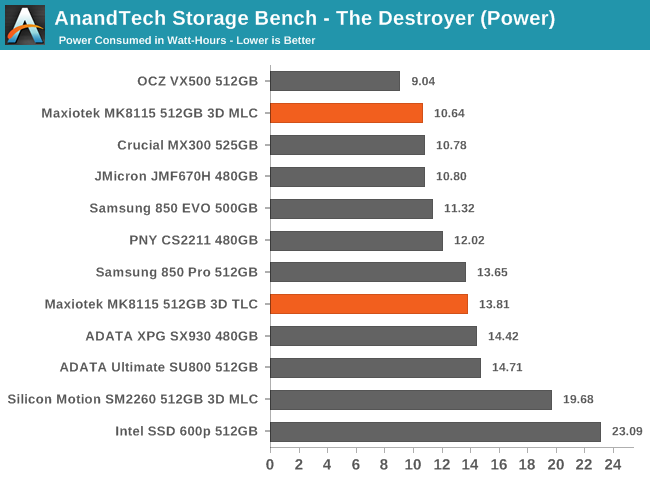
The power efficiency of the MK8115 drives is decent. Even though these drives take a bit longer to complete the test, the total energy used over the course of the test isn't any higher than most of the competition.
AnandTech Storage Bench - Heavy
Our Heavy storage benchmark is proportionally more write-heavy than The Destroyer, but much shorter overall. The total writes in the Heavy test aren't enough to fill the drive, so performance never drops down to steady state. This test is far more representative of a power user's day to day usage, and is heavily influenced by the drive's peak performance. The Heavy workload test details can be found here.
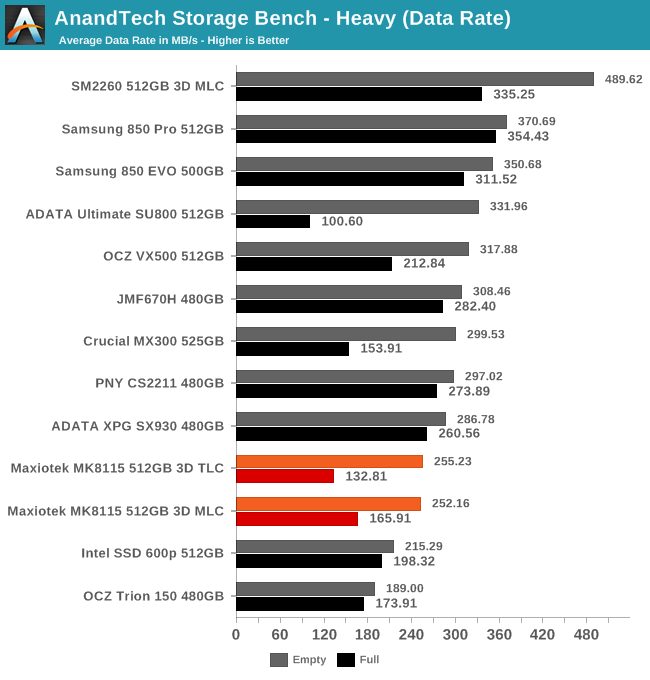
The average data rates of the two MK8115 drives on the Heavy test are almost exactly the same when the test is run on an empty drive. Unfortunately that puts both of them quite near the bottom of the charts, behind the older JMicron drives and the other SATA SSDs using Micron 3D NAND.
When the test is run on a full drive, the MK8115 drives' performance suffers greatly, which has also been true of the other two SATA SSDs with Micron 3D NAND that we've tested. Most other SSDs show a far smaller degradation in performance from a full drive.
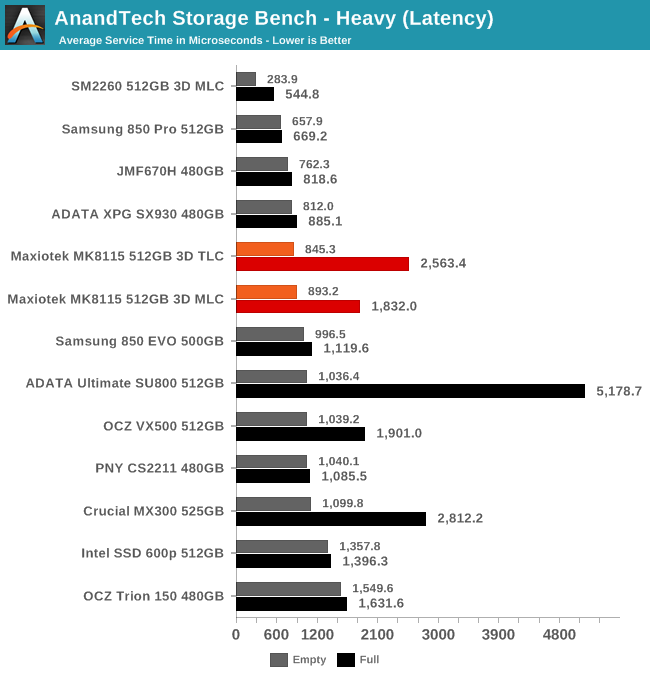
As on The Destroyer, average service times from the MK8115 drives aren't bad at all, if the test is run on an empty SSD. When the drive starts out full, average service time more than doubles, putting the MLC drive only slightly ahead of the OCZ VX500 and the TLC drive a little ahead of the Crucial MX300.
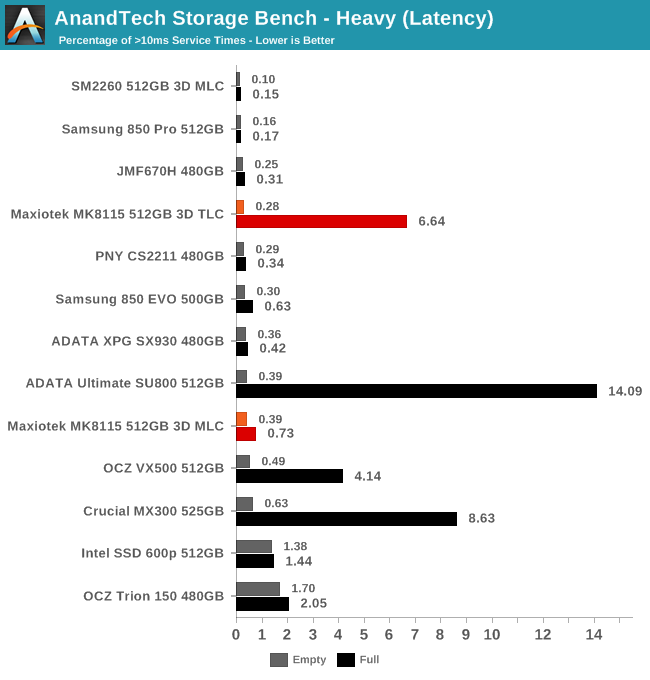
Both MK8115 drives have good control over high latency outliers when the Heavy test is run on an empty drive. The TLC sample surprisingly scores a bit better than the MLC sample. However, when the test is run on a full drive, the MLC sample's performance degradation is moderate while the TLC drive falls apart, though not quite to the extent of the Crucial MX300 or ADATA SU800.
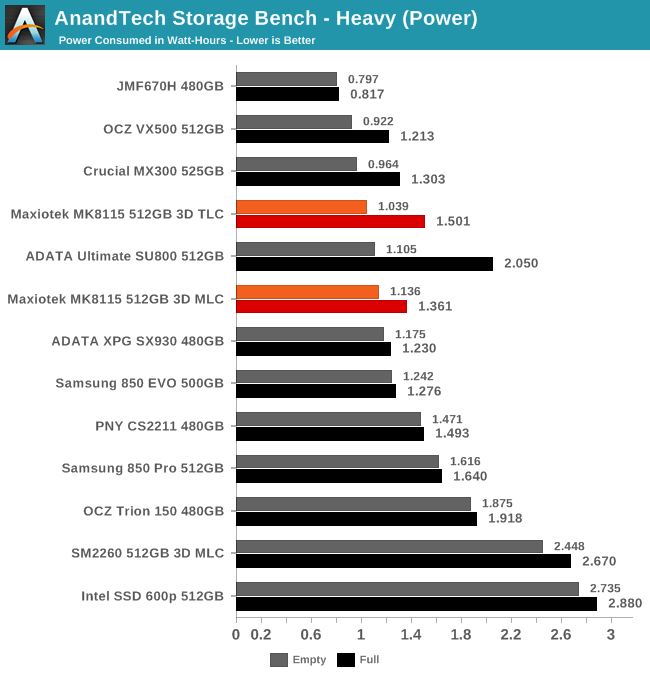
The energy usage scores of the MK8115 drives on the Heavy test are good. The Crucial MX300 is still a bit better overall, but the Micron 3D NAND drives in general are all fairly efficient. They also all suffer noticeably when the test is run on a full drive, but it's not enough to make them worse than the slowest planar TLC SSDs or the fastest MLC SSDs that prioritize performance over power efficiency.
AnandTech Storage Bench - Light
Our Light storage test has relatively more sequential accesses and lower queue depths than The Destroyer or the Heavy test, and it's by far the shortest test overall. It's based largely on applications that aren't highly dependent on storage performance, so this is a test more of application launch times and file load times. This test can be seen as the sum of all the little delays in daily usage, but with the idle times trimmed to 25ms it takes less than half an hour to run. Details of the Light test can be found here.
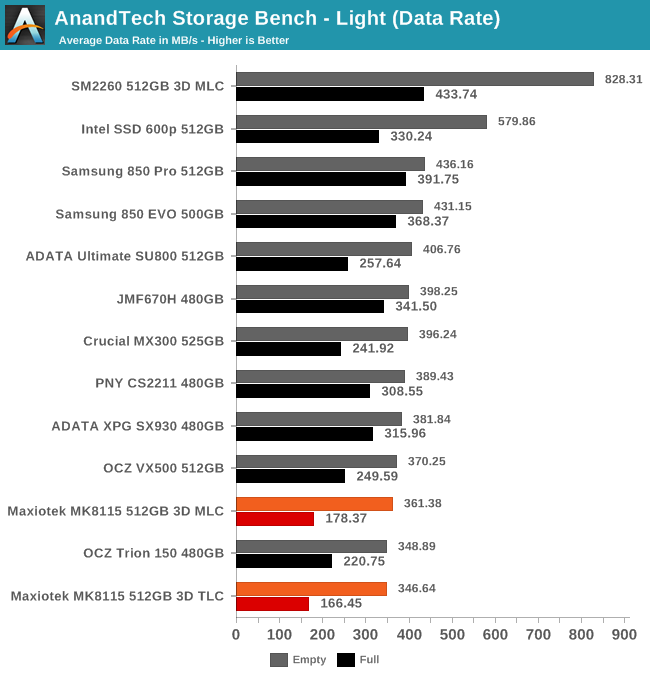
The Light test shows a narrower spread of scores than the other ATSB tests, but the MK8115 drives are in last place with average data rates slightly below their respective OCZ competition, and they trail by a slightly wider margin when the test is run on a full drive. The fastest MLC and TLC SATA SSDs (from Samsung) are 20-25% faster.
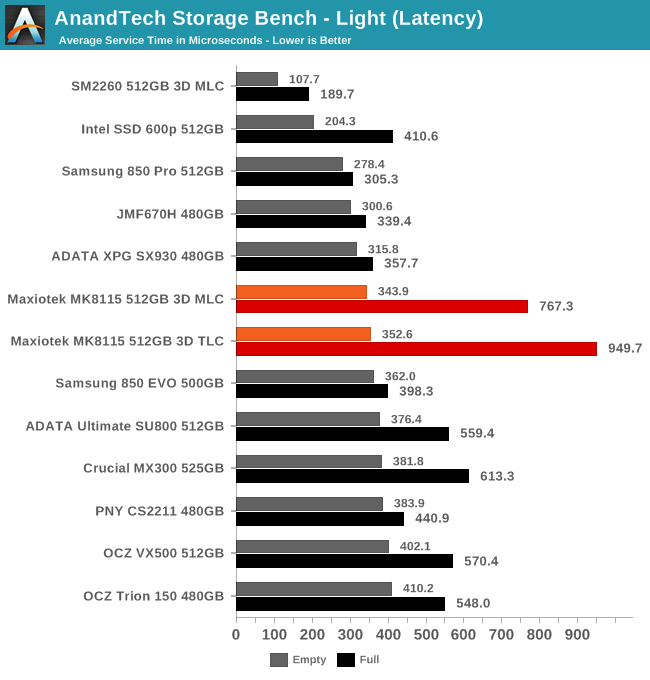
Average service times from the MK8115 samples are on par with other SATA SSDs when the test is run on an empty drive, but when the drive is full service times more than double and are substantially higher than any other SSDs.

The number of high-latency outliers above 10ms experienced by the MK8115 drives when the Light test is run on an empty drive is typical for other SATA SSDs. When the drives are filled before the test, the MK8115 with MLC is affected significantly but not as much as drives like the Crucial MX300 or OCZ VX500. The MK8115 with TLC does far worse and ends up almost three times as many outliers as the next worst-scoring drive (the ADATA SU800).
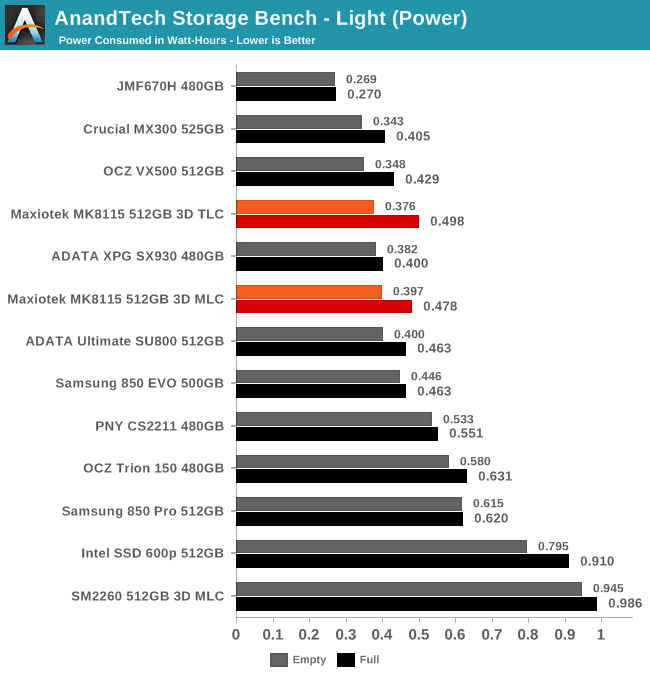
Power consumption for the two MK8115 drives on the Light test is very similar and slightly better than average. The SATA SSDs that consume substantially more power are Samsung's high performers and the two drives using the Phison S10 controller.
Random Read Performance
The random read test requests 4kB blocks and tests queue depths ranging from 1 to 32. The queue depth is doubled every three minutes, for a total test duration of 18 minutes. The test spans the entire drive, which is filled before the test starts. The primary score we report is an average of performances at queue depths 1, 2 and 4, as client usage typically consists mostly of low queue depth operations.
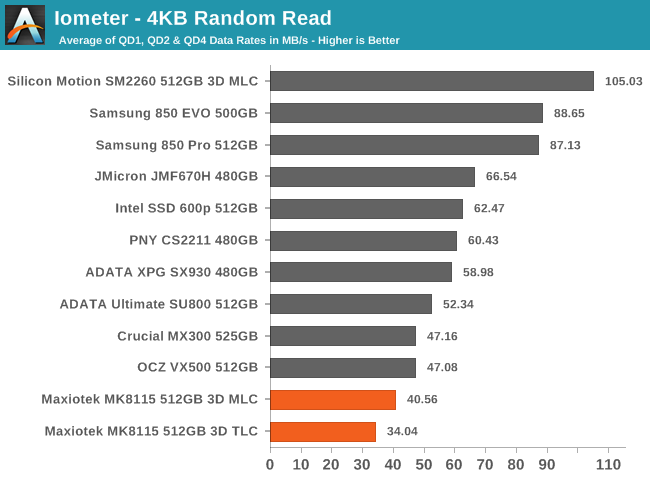
As can be expected, the DRAM-less MK8115 drives come in last in the random read speed test, with the MLC drive 13% slower than the OCZ VX500 and MX300 while the MK8115 TLC drive is closer to 28% slower. Samsung's 850 EVO and PRO are both more than twice as fast as the MK8115 drives.
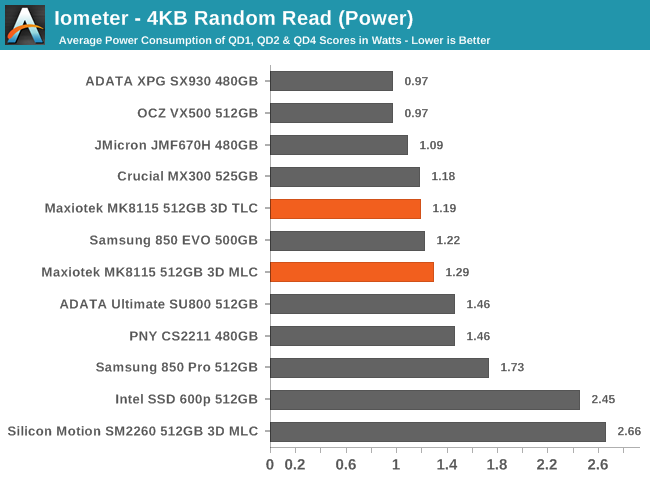
Power consumption during the random read test is reasonable for both MK8115 drives, but the low performance means neither is particularly efficient.
 |
|||||||||
As queue depths increase both MK8115 samples show moderate increases in performance, tapering off slightly between QD16 and QD32. The MK8115 isn't drawing the most power among SATA SSDs at every single queue depth, but it's close.
Random Write Performance
The random write test writes 4kB blocks and tests queue depths ranging from 1 to 32. The queue depth is doubled every three minutes, for a total test duration of 18 minutes. The test is limited to a 16GB portion of the drive, and the drive is empty save for the 16GB test file. The primary score we report is an average of performances at queue depths 1, 2 and 4, as client usage typically consists mostly of low queue depth operations.
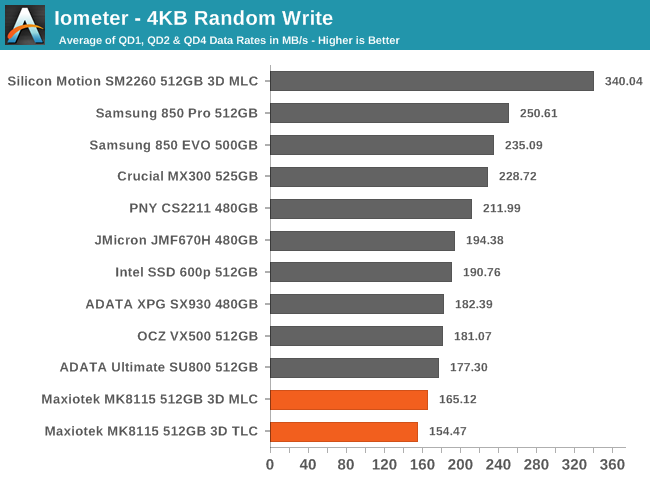
Random write speeds of the MK8115 samples are the slowest out of all the drives in this comparison, but the margin is much smaller than for random reads and nowhere near as large as the disparity in steady-state performance. The difference in performance between the MK8115 samples is smaller than it was for random reads.

The MK8115 drive with MLC levels off after QD8. The TLC counterpart was on track to deliver slightly higher performance at significantly lower power consumption, until the TLC drive filled up and the background garbage collection killed performance and drove up power consumption.
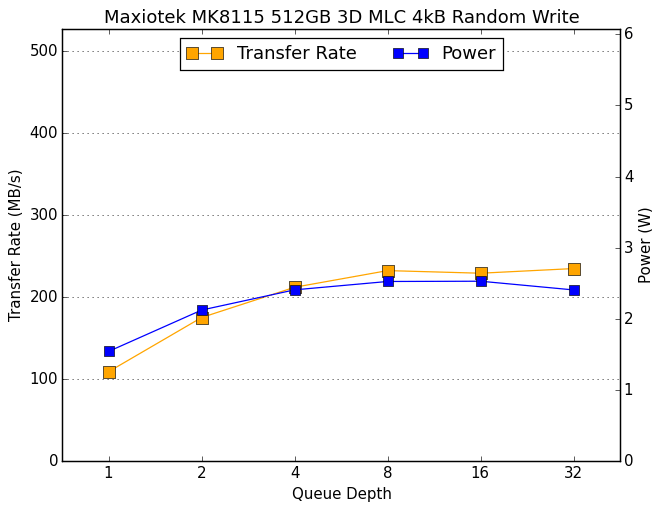 |
|||||||||
The two MK8115 samples behave rather differently during this random write test. The TLC drive starts out slower at QD1 but performance scales better as queue depth climbs. The TLC drive is also substantially more power efficient, with power consumption growing more slowly than throughput. However, by the end of the test the SLC cache has filled, causing performance to drop below the QD1 throughput and power jumps up to be on par with the MLC drive.
Sequential Read Performance
The sequential read test requests 128kB blocks and tests queue depths ranging from 1 to 32. The queue depth is doubled every three minutes, for a total test duration of 18 minutes. The test spans the entire drive, and the drive is filled before the test begins. The primary score we report is an average of performances at queue depths 1, 2 and 4, as client usage typically consists mostly of low queue depth operations.
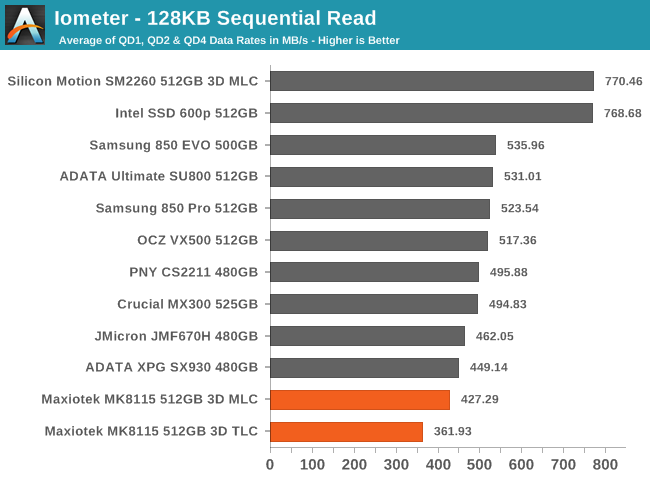
The two MK8115 drives land at the bottom of the performance rankings again for the sequential read test. They aren't really close to saturating the SATA 3 link at low queue depths, but both do at least offer significantly higher throughput than a SATA 2 link could provide, and the fact that the competition is limited by SATA 3 means the MK8115 drives fall behind by a smaller percentage than would otherwise be the case.
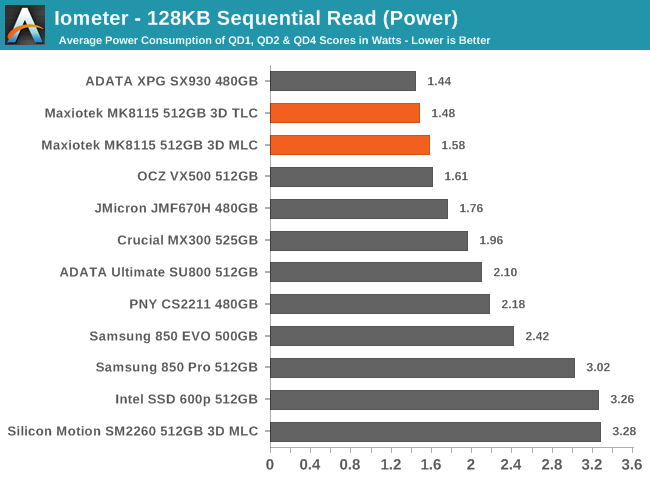
To go with their low performance the MK8115 drives offer almost the lowest power consumption, so the power efficiency is at least reasonable. The ADATA SX930 based on the JMicron JMF670H controller manages to deliver higher throughput with less power, so the lack of a DRAM cache seems to be hurting more than helping efficiency on this test.
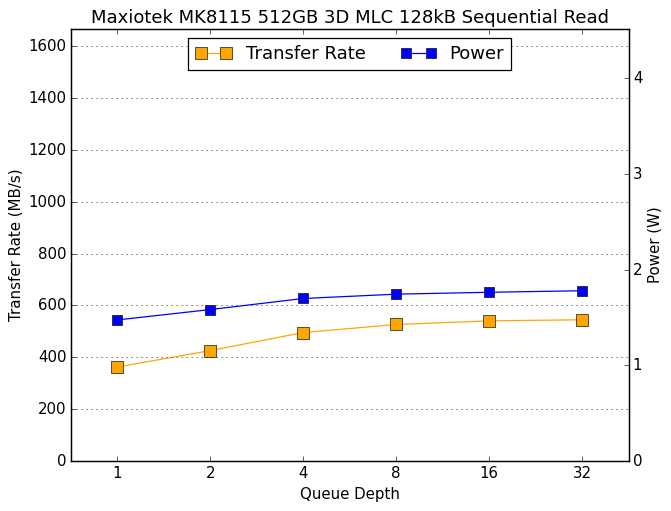 |
|||||||||
Like most SATA drives, the performance scaling as queue depth increases is mostly flat. There's slight performance growth all the up to QD16 while many SATA SSDs are able to offer their full sequential read throughput at QD2.
Sequential Write Performance
The sequential write test writes 128kB blocks and tests queue depths ranging from 1 to 32. The queue depth is doubled every three minutes, for a total test duration of 18 minutes. The test spans the entire drive, and the drive is filled before the test begins. The primary score we report is an average of performances at queue depths 1, 2 and 4, as client usage typically consists mostly of low queue depth operations.
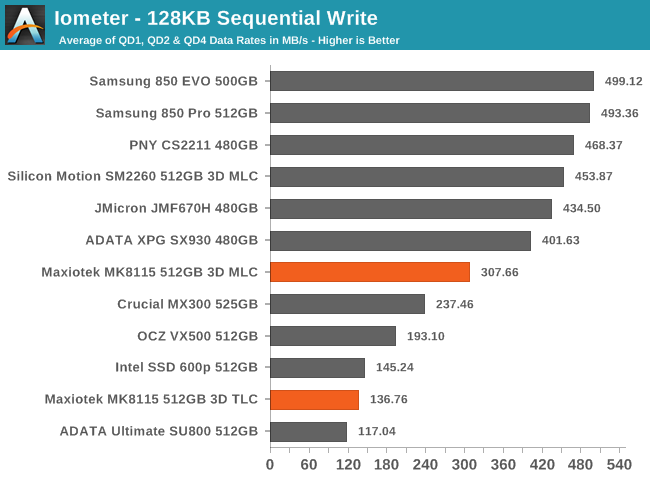
The sequential write test reveals one of the biggest gaps between the MLC and TLC based MK8115 drives. The TLC drive is almost the slowest drive on this test, but the MLC drive is more than twice as fast and outperforms most TLC SSDs while not quite matching typical MLC performance.
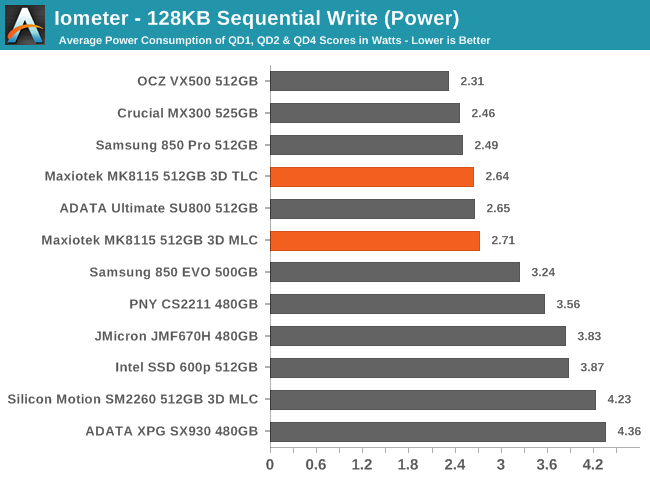
Both MK8115 drives had similar power consumption on the sequential read test, revealing the MLC drive to be far more efficient but still nothing great compared to the competition.
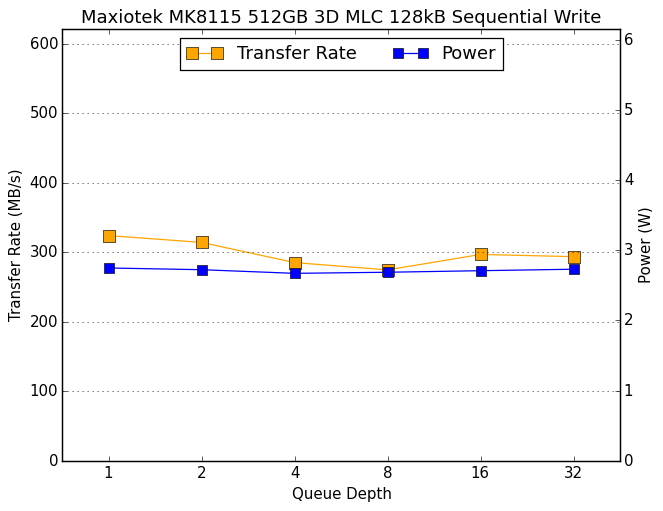 |
|||||||||
The MK8115 drive with MLC experiences a bit of trouble near the middle of the sequential write test, as write speeds drop slightly, but by the end of the test they've mostly recovered and power consumption has been constant across queue depths.
Mixed Random Read/Write Performance
The mixed random I/O benchmark starts with a pure read test and gradually increases the proportion of writes, finishing with pure writes. The queue depth is 3 for the entire test and each subtest lasts for 3 minutes, for a total test duration of 18 minutes. As with the pure random write test, this test is restricted to a 16GB span of the drive, which is empty save for the 16GB test file.
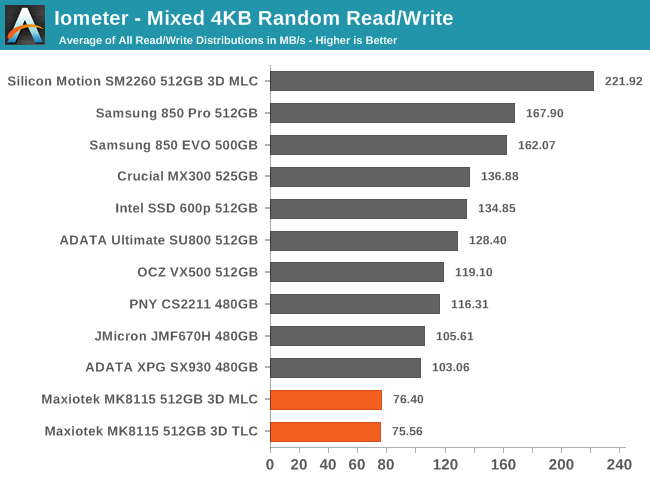
The MK8115 struggled with both random reads and random writes, so it's no surprise to see them turn in the lowest performance scores for the mixed random workload test. The MLC drive is only ahead of the TLC drive by a hair, and the next slowest drive is faster by a third.
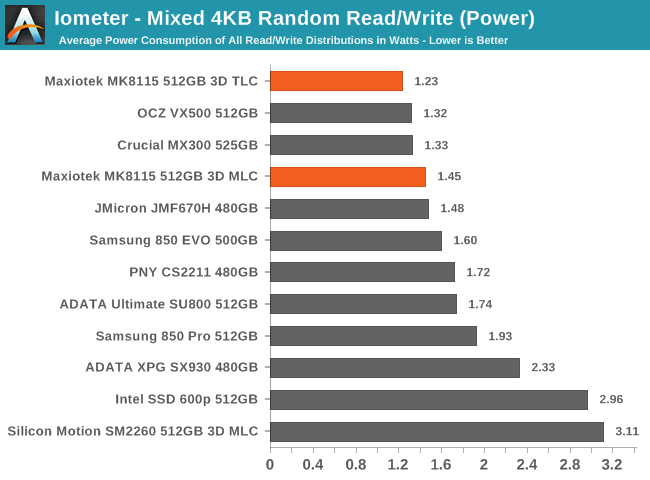
The MK8115 with TLC ends up using less power to deliver almost exactly the same performance, so the TLC drive scores a minor win for efficiency. They're both still beat by a wide range of mainstream SSDs.
 |
|||||||||
Both MK8115 drives show a normal spike in performance at the end of the test when the workload shifts to pure writes. During the rest of the test, performance is mostly constant instead of the more usual pattern of growing steadily with the proportion of writes in the workload. The TLC drive is substantially faster than the MLC drive in the initial all-reads phase of the test, but it is slightly slower through the middle of the test and that gives it the slower overall average.
Mixed Sequential Read/Write Performance
The mixed sequential access test covers the entire span of the drive and uses a queue depth of one. It starts with a pure read test and gradually increases the proportion of writes, finishing with pure writes. Each subtest lasts for 3 minutes, for a total test duration of 18 minutes. The drive is filled before the test starts.
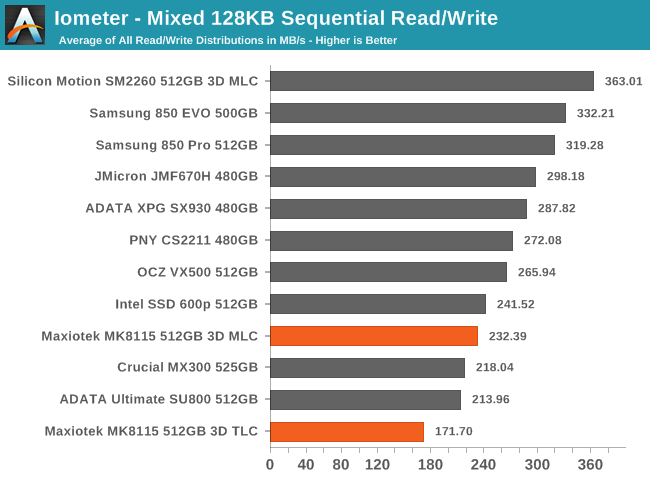
The MK8115 drive with MLC has much higher average performance on the mixed sequential workload test than its TLC counterpart, which is quite clearly the slowest drive. The MLC manages to outperform two TLC drives, but doesn't come close to matching the next slowest MLC drive on this test.
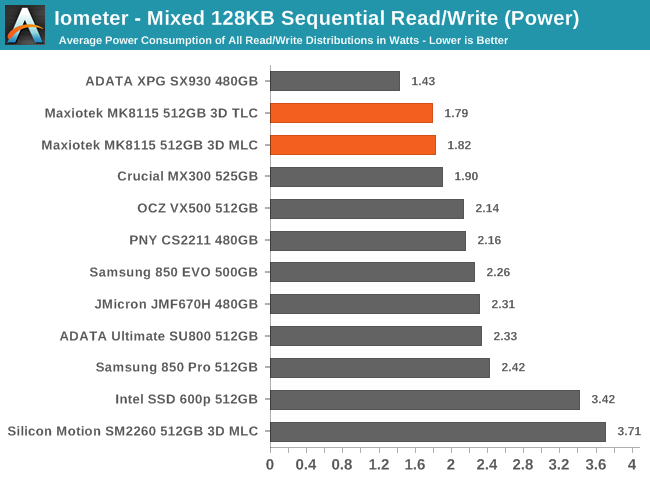
Both MK8115 drives draw about the same amount of power during the mixed sequential workload test. The MLC drive requires slightly more power but is substantially more efficient due to its higher performance, and it actually beats the Crucial MX300 for efficiency here.
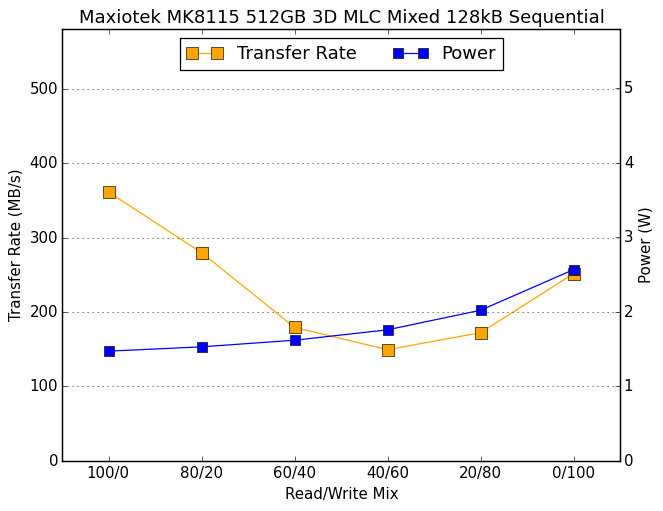 |
|||||||||
The MLC drive's performance curve across the mixed sequential test is the U shape that is normal for mainstream SSDs, though the minimum performance of around 150MB/s is a bit on the low side. The TLC drive by contrast slows down steadily as more writes are added, and doesn't recover any performance near the end of the test.
ATTO
ATTO's Disk Benchmark is a quick and easy freeware tool to measure drive performance across various transfer sizes.
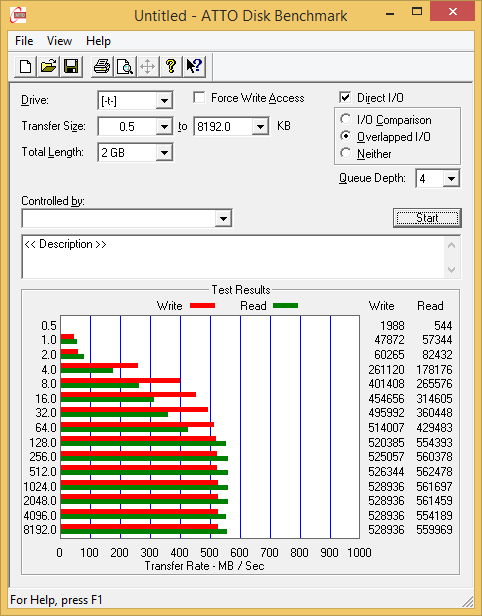 |
|||||||||
Both MK8115 drives have horrible performance on 512-byte transfers, far lower than anything else we've tested in recent memory. Reads are more than 100 times slower for 512B than 1kB transfers, and for writes the difference is a factor of 24. Most filesystems use 4kB or larger block sizes, but 512B accesses are still common enough that this is a fairly severe bug that needs to be dealt with in future firmware.
Beyond 512B transfers, the TLC drive's write speed scales up quicker than the MLC drive, but its read speeds struggle a bit. For 128kB and larger transfers, both drives are operating at full speed and performing similarly to each other and most SATA drives.
AS-SSD
AS-SSD is another quick and free benchmark tool. It uses incompressible data for all of its tests, making it an easy way to keep an eye on which drives are relying on transparent data compression. The short duration of the test makes it a decent indicator of peak drive performance.
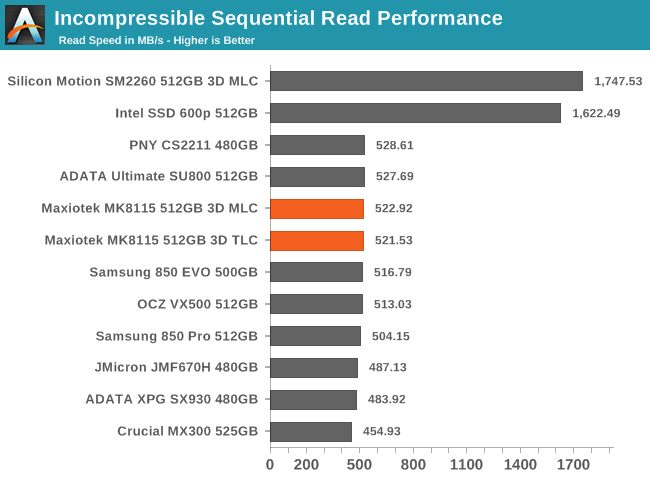
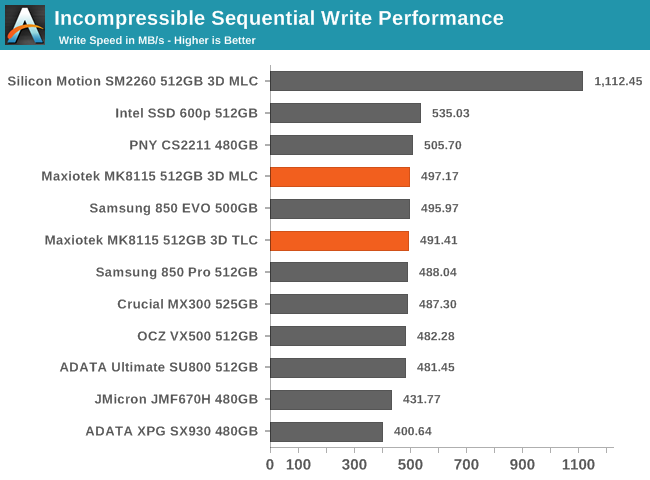
The MK8115 controller does make use of some compression, but its peak sequential read and writes speeds are not reliant upon the data being compressible. The MK8115 drives give AS-SSD performance that is typical for drives that are large enough to saturate the SATA link.
Idle Power Consumption
Since the ATSB tests based on real-world usage cut idle times short to 25ms, their power consumption scores paint an inaccurate picture of the relative suitability of drives for mobile use. During real-world client use, a solid state drive will spend far more time idle than actively processing commands. Our testbed doesn't support the deepest DevSlp power saving mode that SATA drives can implement, but we can measure the power usage in the intermediate slumber state where both the host and device ends of the SATA link enter a low-power state and the drive is free to engage its internal power savings measures.
We also report the drive's idle power consumption while the SATA link is active and not in any power saving state. Drives are required to be able to wake from the slumber state in under 10 milliseconds, but that still leaves plenty of room for them to add latency to a burst of I/O. Because of this, many desktops default to either not using SATA Aggressive Link Power Management (ALPM) at all or to only enable it partially without making use of the device-initiated power management (DIPM) capability. Additionally, SATA Hot-Swap is incompatible with the use of DIPM, so our SSD testbed usually has DIPM turned off during performance testing.
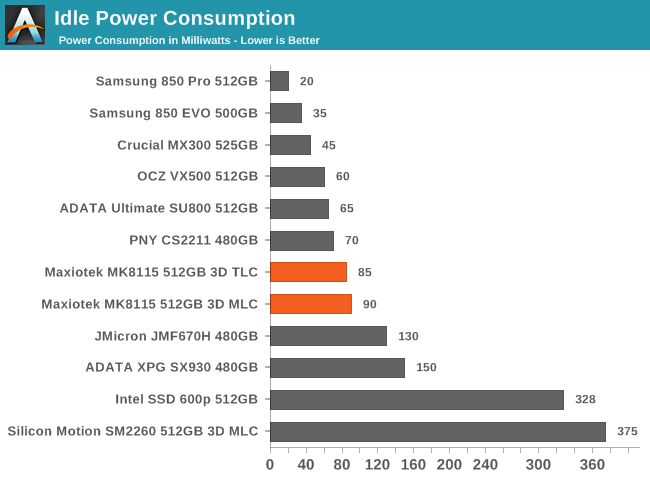
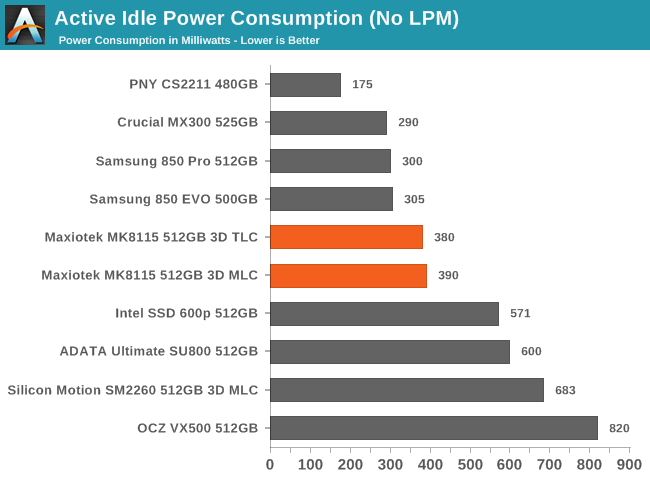
Idle power of the MK8115 is significantly improved over the JMF670H, but still lagging slightly behind the Phison-based PNY CS2211 and nowhere near the best SATA SSDs. Samsung and Marvell use more advanced lithography nodes for their controllers, and the smaller competitors on lagging fabrication processes can't beat them.
The active idle power consumption of the MK8115 drives is decent: it's clearly better than for the Silicon Motion drives or the OCZ VX500, but not quite as good as the Samsung and Marvell drives, nor the unusually efficient PNY CS2211.
Final Words
The Maxiotek MK8115 is the first completely DRAM-less SSD platform we've tested in quite a while. DRAM-less SSDs haven't been a popular mainstream choice since SandForce drives were competitive, but they haven't entirely disappeared from the market either. Both Silicon Motion and Phison have continually offered DRAM-less controllers as part of their product lines, and they've been used for the entry-level SSDs of many brands. The problem with DRAM-less SSDs is that they are invariably afflicted with lower performance, and they seldom offer enough of a discount to make up for it.
Despite having SLC caching, plenty of overprovisioning and using 3D NAND, the Maxiotek MK8115 doesn't pull off any magic tricks. Its performance is usually substantially below that of mainstream SSDs with large DRAM caches. The MK8115 drive with MLC NAND is faster than the one with TLC, but still often slower than competing entry-level TLC drives. On average, the MK8115 with MLC or TLC is at least close to modern mainstream SSDs; it would be hobbled operating with a 3Gb/s SATA 2 link.
The big weakness of the MK8115 drives is the corner cases: when its performance drops, it gets *really* bad. Our test of steady-state random write performance on a full drive is not representative of any real-world client workload, but it is still a bit worrying to see the MK8115 drives outperformed by other low-end drives by a factor of five or ten. The ATTO disk benchmark revealed that the MK8115 delivers extremely poor performance for 512-byte transfers, with 512B reads giving less than 1% of the throughput from 1kB reads. Analyzing the latency patterns from our ATSB real-world workload tests shows that the MK8115 delivers reasonable average latency, but it is much more prone to outliers of unusually high latency.
The MK8115 controller is intended for use in client and consumer SSDs with entry-level market positions. Thus, the results from the sample with MLC NAND, while very useful for analyzing the controller itself, are unlikely to represent any real product. The slower TLC-based drives are what will actually be on the market, and what should be the primary indicator of how retail MK8115 drives will behave. Those products, starting with the ADATA Ultimate SU700, will offer SSD-like performance most of the time. They won't be fast enough to be a performance upgrade from any SSD that's only a few years old, but they'll still be much faster than a hard drive. The MK8115 also offers the usual power efficiency advantages of SSDs and 3D NAND, though drives like the Crucial MX300 are more efficient still despite running a DRAM cache.
More than any drive we've reviewed recently, the MK8115 platform needs to come with the caveat that it is not suitable for every workload. These drives are fine for light client workloads, but they don't do well when full and their random access performance is sub-par.
As the memory industry continues to experience a shortage of flash memory and as DRAM prices are climbing, now is the best possible time for DRAM-less drives to hit the market. They offer the best short-term prospect for lowering SSD prices or keeping them from growing too much. The supply constraints are forcing manufacturers to either raise SSD prices or compromise on performance. The MK8115 could be a reasonable option for products that are sacrificing performance, but only if the price savings are significant enough to matter. The ADATA SU700 is not yet widely available, but so far the pricing on the 120GB and 240GB models is not close to competitive. As the market shifts over the next several months it could end up as one of the cheapest options, or other factors may keep the Crucial MX300 on its throne as the best value SSD until 64+ layer 3D NAND starts to affect the market.

